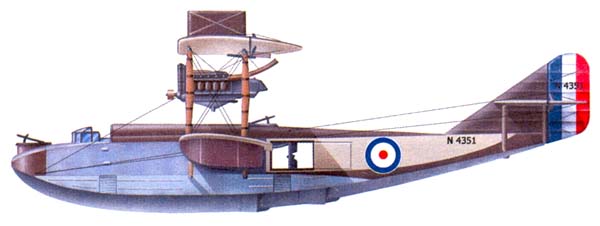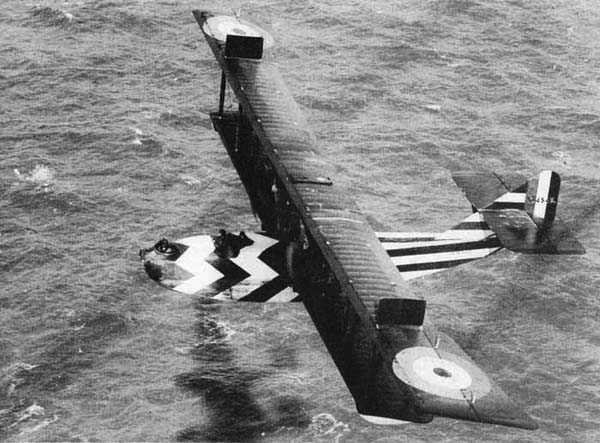
|
 |
Felixstowe F.2A |
 |
 |
 |
 |
 |
|---|---|---|---|---|---|---|---|
 |
 |
 |
 |
 |
|||
 |
||
|
The F.2A operated on anti-submarine patrol missions. Each plane could carry two 230 lb (104 kg) bombs under the lower wings. It was also defended by a machine gun position in the nose and three machine guns at mid-fuselage stations.
| ||
|
The Felixstowe F.2A was a first-class flying machine, capable of long patrols. It carried two pilots and an armament varying from four to seven
Lewis machine-guns: single or twin guns in each of the front and rear cockpits, another above the pilot's seats and sometimes a beam gun on either side. Two 230 lb (104 kg) bombs could be carried beneath the lower wings.
The Felixstowe inherited the 'spider's web' patrolling of the North Sea from the Curtiss H.12, and scored numerous successes over enemy submarines and airships. Despite its size and weight, the F.2A could maneuver quite well, and was an opponent treated with a healthy respect by enemy seaplane fighters. By various improvisations some Felixstowe F.2As could carry enough fuel for more than nine hours' flying, but in the spring of 1918 an alternative attempt was made to increase the combat radius, by towing the aircraft on a lighter behind a Royal Navy destroyer into the scene of action. However, so far as is known, little operational use was made of this procedure. The Felixstowe's major weakness lay in the fuel supply system, which often obliged the crew to bring it down on the sea. |
| In the summer of 1918, the so called 'dazzle painting' was introduced on F.2A's in order to prevent it from being attacked as an enemy aircraft. Operating over the North Sea, different schemes evolved to identify individual aircraft. The F.2A's wartime activities were confined to British home waters and on October 31, 1918, there were fifty-three of these aircraft on RAF charge. One example (N65) was completed as an F.2C, with a lightweight hull and modified nose turret. This was later used operationally from RNAS Felixstowe and was involved in the destruction of the submarine U.C.1 in July 1917. |
|
Development began in 1914 when Ron Wanamaker, a wealthy American department store owner and supporter of aeronautics hoped to fly across the Atlantic, to compete for the prize of 10,000 British Sterling offered by British publisher and aviation enthusiast, Lord Northclif (1913) of the London Daily Mail.
An order to produce an aircraft to make the Atlantic flight was accepted by Glenn Curtiss and he developed a large flying boat powered by two 90 hp Curtiss OX engines. The aircraft was called the America.1 The ocean-crossing attempt was planned for 1914, to commemorate the centennial of the cessation of hostilities between the United States and Great Britain in 1814. The former Royal Navy officer and acquaintance of Curtiss, John Cyril Porte, was chosen as pilot, and American George Hallett was later selected as the co-pilot. With the onset of WWI, the flight was cancelled and John Porte returned to England for duty with the Royal Naval Air Service as a squadron commander and took command of the Felixstowe Naval Air Station. At the request of squadron commander John Cyril Porte, the RNAS bought two flying boats of the America type. The military version of the America became the H.4. The aircraft were delivered in November 1914 and were sent to Felixstowe for trials. However, there were shortcomings with the H.4 and a completely redesigned Porte hull was developed. The new aircraft incorporated the wings and tail unit of the Curtiss H.4, along with the improved Porte hull and with 100 hp Anzanis engines, was now designated the F.1. 2 With the success of the trials, an additional fifty similar aircraft were ordered.

'Dazzle Painting' was introduced on F.2As operating over the North Sea. In July 1916, Curtiss completed the H.8 prototype with two 160 hp Curtiss engines. This was similar to the H.4, but considerably larger. Severely underpowered, the engines were replaced with 250 hp Rolls Royce Eagle I engines for the RNAS. (The RNAS called the H.12 the Large America, and the H.4 the Small America.) 3 Once in the air, the H.12 demonstrated excellent flying characteristics, but the hull exhibited a weakness that was also a characteristic of the H.4., and substantial hull modifications were required. 4 The new hull, the Porte II, was a strong and seaworthy design with structural simplicity, which enabled it to be made by firms with little boat building experience and was designated the F.2. The production aircraft was refitted with 345 hp Rolls Royce Eagle VIII engines5 and designated the F.2A. Deliveries began to be made at the end of 1917 and during 1918, the F.2A was in use at almost every flying boat station of the RNAS. On May 10th, 1918, an F.2A from Killingholme; flown by Captains T. C. Pattinson and A. H. Munday, engaged the Zeppelin L.62 at 8,000 feet over the Heligoland minefields. Captain Munday opened fire from the bow cockpit and Sergeant H. R. Stubbington, the engineer, also brought his Lewis gun to bear on the target. Many hits appeared to be scored, but the flying boat broke an oil line and had to land on the sea. The Zeppelin made off due east, losing height and emitting smoke, and soon afterwards blew up and fell in flames. |
| Specifications: | |
|---|---|
| The Felixstowe F.2A | |
| Dimensions: | |
| Upper wing span: | 95 ft 7.5 in (29.13 m) |
| Lower wing span: | 68 ft 5 in (20.86 m) |
| Length: | 46 ft 3 in (14.05 m) |
| Height: | 17 ft 6 in (5.33 m) |
| Weights: | |
| Max T/O weight: | 10,978 lb (4,536 kg) |
| Performance: | |
| Maximum Speed: | 95 mph (193 km/h) |
| Endurance: | 6 Hours |
| Powerplant: | |
| Two 345 h.p. (257 kW) Rolls Royce Eagle VIII engines. | |
| Armament: | |
| Four Lewis machine-guns: One was on a Scarff ring-mounting on the nose cockpit; another was mounted in the upper rear cockpit behind the wings; and one in each waist position. Two 230 lb. bombs were carried in racks under the lower mainplane. | |
|
1. Murray Rubenstein and Richard M. Goldman. To Join with Eagles. Doubleday & Company, Inc., 1974. 30. |
©Larry Dwyer. The Aviation History On-Line Museum.
All rights reserved.
Created January 8, 2006. Updated October 17, 2013.